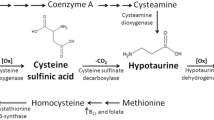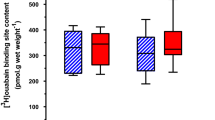Abstract
This study investigated the effect of taurine and β-alanine supplementation on muscle function and muscle taurine transporter (TauT) protein expression in mdx mice. Wild-type (WT) and mdx mice (5 months) were supplemented with taurine or β-alanine for 4 weeks, after which in vitro contractile properties, fatigue resistance and force recovery, and the expression of the TauT protein and proteins involved in excitation–contraction (E–C) coupling were examined in fast-twitch muscle. There was no difference in basal TauT protein expression or basal taurine content between mdx than WT muscle. Supplementation with taurine and β-alanine increased and reduced taurine content, respectively, in muscle from WT and mdx mice but had no effect of TauT protein. Taurine supplementation reduced body and muscle mass, and enhanced fatigue resistance and force recovery in mdx muscle. β-Alanine supplementation enhanced fatigue resistance in WT and mdx muscle. There was no difference in the basal expression of key E–C coupling proteins [ryanodine receptor 1 (RyR1), dihydropyridine receptor (DHPR), sarco(endo)plasmic reticulum Ca2+-ATPase 1 (SERCA1) or calsequestrin 1 (CSQ1)] between WT and mdx mice, and the expression of these proteins was not altered by taurine or β-alanine supplementation. These findings suggest that TauT protein expression is relatively insensitive to changes in muscle taurine content in WT and mdx mice, and that taurine and β-alanine supplementation may be viable therapeutic strategies to improve fatigue resistance of dystrophic skeletal muscle.






Similar content being viewed by others
References
Allen DG, Whitehead NP (2011) Duchenne muscular dystrophy: What causes the increased membrane permeability in skeletal muscle? Int J Biochem Cell Biol 43:290–294
Allen D, Zhang B-T, Whitehead N (2010) Stretch-Induced Membrane damage in muscle: comparison of wild-type and mdx mice. Adv Exp Med Biol 682:297–313
Baltgalvis KA, Call JA, Nikas JB, Lowe DA (2009) Effects of prednisolone on skeletal muscle contractility in mdx mice. Muscle Nerve 40:443–454
Bank WJ, Rowland LP, Ipsen J (1971) Amino acids of plasma and urine in diseases of muscle. Arch Neurol 24:176–186
Barclay CJ (2005) Modelling diffusive O(2) supply to isolated preparations of mammalian skeletal and cardiac muscle. J Muscle Res Cell Motil 26:225–235
Bellinger AM et al (2009) Hypernitrosylated ryanodine receptor calcium release channels are leaky in dystrophic muscle. Nat Med 15:325–330
Boldyrev AA, Aldini G, Derave W (2013) Physiology and pathophysiology of carnosine. Physiol Rev 93:1803–1845
Brooks SV, Faulkner JA (1988) Contractile properties of skeletal muscles from young, adult and aged mice. J Physiol 404:71–82
Bushby K et al (2010) Diagnosis and management of Duchenne muscular dystrophy, part 2: implementation of multidisciplinary care. Lancet Neurol 9:177–189
Camerino DC et al (2004) Taurine and skeletal muscle disorders. Neurochem Res 29:135–142
Cozzoli A et al (2011) Evaluation of potential synergistic action of a combined treatment with alpha-methyl-prednisolone and taurine on the mdx mouse model of Duchenne muscular dystrophy. Neuropathol Appl Neurobiol 37:243–256
Culligan K, Banville N, Dowling P, Ohlendieck K (2002) Drastic reduction of calsequestrin-like proteins and impaired calcium binding in dystrophic mdx muscle. J Appl Physiol 92:435–445
De Luca A, Pierno S, Camerino C, Huxtable RJ, Camerino DC (1998) Effect of taurine on excitation-contraction coupling of extensor digitorum longus muscle of dystrophic mdx mouse. Adv Exp Med Biol 442:115–119
De Luca A et al (2001) Alteration of excitation-contraction coupling mechanism in extensor digitorum longus muscle fibres of dystrophic mdx mouse and potential efficacy of taurine. Br J Pharmacol 132:1047–1054
De Luca A, Pierno S, Liantonio A, Conte Camerino D (2002) PrE–Clinical trials in Duchenne dystrophy: what animal models can tell us about potential drug effectiveness Neuromuscul Disord 12(Suppl 1):S142–S146
De Luca A et al (2003) Enhanced dystrophic progression in mdx mice by exercise and beneficial effects of taurine and insulin-like growth factor-1. J Pharmacol Exp Ther 304:453–463
De Luca A, Pierno S, Camerino DC (2015) Taurine: the appeal of a safe amino acid for skeletal muscle disorders. J Transl Med 13:243
Desguerre I, Mayer M, Leturcq F, Barbet JP, Gherardi RK, Christov C (2009) Endomysial fibrosis in Duchenne muscular dystrophy: a marker of poor outcome associated with macrophage alternative activation. J Neuropathol Exp Neurol 68:762–773
Divet A, Lompre AM, Huchet-Cadiou C (2005) Effect of cyclopiazonic acid, an inhibitor of the sarcoplasmic reticulum Ca-ATPase, on skeletal muscles from normal and mdx mice. Acta Physiol Scand 184:173–186
Emery A (1995) Muscular dystrophy–the facts. Neuromuscul Disord 5:521
Everaert I, Stegen S, Vanheel B, Taes Y, Derave W (2013) Effect of beta-alanine and carnosine supplementation on muscle contractility in mice. Med Sci Sports Exerc 45:43–51
Fauconnier J et al (2010) Leaky RyR2 trigger ventricular arrhythmias in Duchenne muscular dystrophy. Proc Natl Acad Sci U S A 107:1559–1564
Goodman CA, Horvath D, Stathis C, Mori T, Croft K, Murphy RM, Hayes A (2009) Taurine supplementation increases skeletal muscle force production and protects muscle function during and after high-frequency in vitro stimulation. J Appl Physiol 107:144–154
Grosso DS, Roeske WR, Bressler R (1978) Characterization of a Carrier-Mediated Transport System for Taurine in the Fetal Mouse Heart In Vitro. J Clin Invest 61:944–952
Grounds MD, Radley HG, Lynch GS, Nagaraju K, De Luca A (2008) Towards developing standard operating procedures for prE–Clinical testing in the mdx mouse model of Duchenne muscular dystrophy. Neurobiol Dis 31:1–19
Hamilton EJ, Berg HM, Easton CJ, Bakker AJ (2006) The effect of taurine depletion on the contractile properties and fatigue in fast-twitch skeletal muscle of the mouse. Amino Acids 31:273–278
Huxtable RJ (1992) Physiological actions of taurine. Physiol Rev 72:101–163
Ito T et al (2008) Taurine depletion caused by knocking out the taurine transporter gene leads to cardiomyopathy with cardiac atrophy. J Mol Cell Cardiol 44:927–937
Ito T et al (2010) Cardiac and skeletal muscle abnormality in taurine transporter-knockout mice. J Biomed Sci 17:S20
Ito T, Yoshikawa N, Inui T, Miyazaki N, Schaffer SW, Azuma J (2014) Tissue Depletion of Taurine Accelerates Skeletal Muscle Senescence and Leads to Early Death in Mice. PLoS ONE 9:e107409
Kargacin ME, Kargacin GJ (1996) The sarcoplasmic reticulum calcium pump is functionally altered in dystrophic muscle. Biochim Biophys Acta 1290:4–8
Karpati G, Carpenter S (1986) Small-caliber skeletal muscle fibers do not suffer deleterious consequences of dystrophic gene expression. Am J Med Genet 25:653–658
Kingston R, Kearns S, Kelly C, Murray P (2005) Effects of systemic and regional taurine on skeletal muscle function following ischaemia-reperfusion injury. J Orthop Res 23:310–314
Koenig M, Hoffman EP, Bertelson CJ, Monaco AP, Feener C, Kunkel LM (1987) Complete cloning of the Duchenne muscular dystrophy (DMD) cDNA and preliminary genomic organization of the DMD gene in normal and affected individuals. Cell 50:509–517
McIntosh L, Granberg KE, Brière KM, Anderson JE (1998) Nuclear magnetic resonance spectroscopy study of muscle growth, mdx dystrophy and glucocorticoid treatments: correlation with repair. NMR Biomed 11:1–10
Mendez J, Keys A (1960) Density and composition of mammalian skeletal muscle Metab Clin Exp 9:184–199
Morel JL, Rakotoarisoa L, Jeyakumar LH, Fleischer S, Mironneau C, Mironneau J (2004) Decreased expression of ryanodine receptors alters calcium-induced calcium release mechanism in mdx duodenal myocytes. J Biol Chem 279:21287–21293
Passaquin AC, Renard M, Kay L, Challet C, Mokhtarian A, Wallimann T, Ruegg UT (2002) Creatine supplementation reduces skeletal muscle degeneration and enhances mitochondrial function in mdx mice. Neuromuscul Disord 12:174–182
Schaffer S, Takahashi K, Azuma J (2000) Role of osmoregulation in the actions of taurine. Amino Acids 19:527–546
Schaffer SW, Azuma J, Mozaffari M (2009) Role of antioxidant activity of taurine in diabetes. Can J Physiol Pharmacol 87:91–99
Schaffer S, Ju Jong C, Kc R, Azuma J (2010) Physiological roles of taurine in heart and muscle. J Biomed Sci 17:S2
Schertzer JD, Poel CVD, Shavlakadze T, Grounds MD, Lynch GS (2008) Muscle-specific overexpression of IGF-I improves E–C coupling in skeletal muscle fibers from dystrophic mdx mice. Am J Physiol Cell Physiol 294:C161–C168
Shaffer JE, Kocsis JJ (1981) Taurine mobilizing effects of beta alanine and other inhibitors of taurine transport. Life Sci 28:2727–2736
Straub V, Rafael JA, Chamberlain JS, Campbell KP (1997) Animal Models for Muscular Dystrophy Show Different Patterns of Sarcolemmal Disruption. J Cell Biol 139:375–385
Terrill JR, Grounds MD, Arthur PG (2015) Taurine deficiency, synthesis and transport in the mdx mouse model for Duchenne Muscular Dystrophy. Int J Biochem Cell Biol 66:141–148
Terrill JR, Pinniger GJ, Graves JA, Grounds MD, Arthur PG (2016) Increasing taurine intake and taurine synthesis improves skeletal muscle function in the mdx mouse model for Duchenne Muscular Dystrophy. J Physiol 594:3095–3110
Turgeman T et al (2008) Prevention of muscle fibrosis and improvement in muscle performance in the mdx mouse by halofuginone. Neuromuscul Disord 18:857–868
Warskulat U et al (2004) Taurine transporter knockout depletes muscle taurine levels and results in severe skeletal muscle impairment but leaves cardiac function uncompromised. FASEB J 18:577–579
Whitehead NP, Yeung EW, Allen DG (2006) Muscle damage in mdx (dystrophic) mice: role of calcium and reactive oxygen species. Clin Exp Pharmacol Physiol 33:657–662
Yatabe Y, Miyakawa S, Ohmori H, Mishima H, Adachi T (2009) Effects of taurine administration on exercise. Adv Exp Med Biol 643:245–252
Acknowledgments
We would like to thank Professor David Pow (Royal Melbourne Institute of Technology, Australia) for kindly providing the anti-taurine transporter antibody used in this study. The monoclonal antibodies were deposited to the Development Studies Hybridoma Bank, under the auspices of the NICHD and maintained by the University of Iowa, Department of Biological Sciences, Iowa City, IA 52242, USA. Dystrophin was deposited by G.E. Morris (DSHB Hybridoma Product MANDYS1(3B7)), RyR1 was deposited by J. Airey and J. Sutko (DSHB Hybridoma Product 34C), DHPR was deposited by K.P. Campbell (DSHB Hybridoma Product IIID5E1), SERCA1 was deposited to the DSHB by D.M. Fambrough (DSHB Hybridoma Product CaF2-5D2).
Author information
Authors and Affiliations
Corresponding author
Ethics declarations
Conflict of interest
The authors declare that they have no conflict of interest.
Ethical approval
All procedures performed in studies involving animals were in accordance with the ethical standards of the institution or practice at which the studies were conducted.
Rights and permissions
About this article
Cite this article
Horvath, D.M., Murphy, R.M., Mollica, J.P. et al. The effect of taurine and β-alanine supplementation on taurine transporter protein and fatigue resistance in skeletal muscle from mdx mice. Amino Acids 48, 2635–2645 (2016). https://doi.org/10.1007/s00726-016-2292-2
Received:
Accepted:
Published:
Issue Date:
DOI: https://doi.org/10.1007/s00726-016-2292-2




